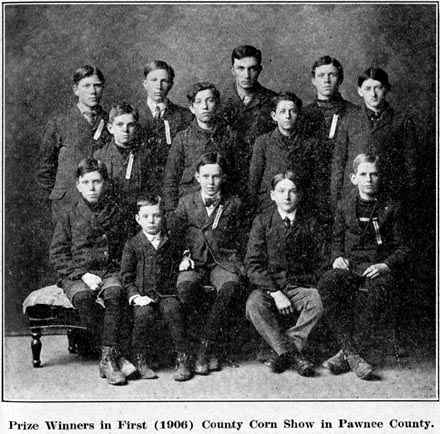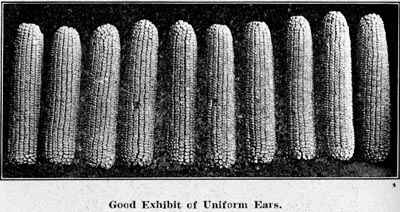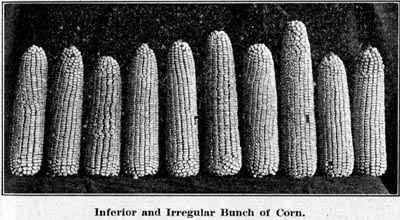
NEGenWeb
Project
Resource Center
Schools
|
|
275 |

Corn has been collected successfully and easily by making a hole in one side of a common grain sack near the top. The ear can be slipped through the hole, leaving the hand free. One can select about three-fourths bushel by this method before emptying the sack.
Where a large quantity of seed is to be selected it is better to make a seed corn sled. These sleds much resemble the old fashioned stone boats. Make a box about three feet wide, two feet high and eight feet long. Fasten this to runners made by rounding off the ends of two half cedar posts or two railroad ties. Place two uprights in the center of the box one at each end. Let them protrude about four feet above the sides of the box. Stretch a strong piece of canvas between the up rights. Fasten a single-tree to the runner and your sled is complete. It is advisable to place a wire muzzle on the horse to prevent it from tearing off the ears and breaking down the stalks. The sled can be drawn between the rows, thus making no "down row." A man can select the best seed ears from ten rows on each side of the sled. The
|
276 |
|
canvas is stretched over the center of the sled and acts as a sort of "bang-board" when the ears are thrown against it. One man can select about five bushels of good seed in eight hours by using either the sack or basket method. He should be able to double that amount when the see corn sled is brought into use.

STORING SEED CORN.
After the corn has been selected it should be stored carefuly (sic) and in such a place that it will dry out quickly but naturally. Many corn growers make a mistake by throwing their seed in some out of the way place where it cannot dry out thoroughly. I have seen corn stored in salt-barrels, vegetable cellars, boxes, potato caves, and other damp, unventilated places, and the next spring, the owners of the seed wondered why they had such a poor stand.
Many of us are making a mistake by throwing our seed corn on top of the oats in the oat bin. The oats go through a certain process of "sweating" in which they give off considerable moisture. This moisture is of course detrimental to the seed corn. Experiments have proven that in almost every case where corn was stored in the barn, hog house, hen house or near any of the farm animals, the vitality has been reduced. This is doubtless due to the moisture given off by the animals.
Many of us practice piling or "ricking" our seed corn along the wall in a close room or bin. The ears are laid one on top of another, touching each other on three or four sides. It is impossible for corn piled in this way to dry out thoroughly without molding more or less.
There are many desirable ways of storing seed corn. Any method that will keep the ears from coming into direct contact with each other or some other object is good. There are so many ways this can be
|
|
277 |

done that it hardly seems necessary to give specific directions, however for the amateur a few suggestions may not come amiss.
Experiment Stations have proven that one of the cheapest and best ways to store seed corn is by tying the ears together in lots of ten with a strong piece of binder-twine looped around the middle of each ear. (See illustration.) This allows ample circulation of air and if the strings are tied to wires suspended between rafters, mice cannot get at it.
Another excellent method, much faster than the one just described, is the "see-saw" method illustrated by the photographs. The "seed corn tree" has been used very successfully and can be made at little expense. The two base boards are made of one by four inch lumber, are thirty-six inches long and are notched so that the edges of both boards touch the ground squarely. Any discarded pan slipped over the top of the post before the nails are driven, will prevent the mice from damaging the corn. The nails to hold the ears are ten-penny finishing nails. They should be driven at an upward slant of forty-five degrees. This will prevent the ears from falling off during the drying process. The upright is usually a seven foot, round cedar post. If the nails are arranged carefully a "seed corn tree' can be made to hold five bushels.
Wire chicken netting strung between rafters has been used as a place to store seed corn with limited success. The ears which are pushed through the meshes in the wire often fall out during the drying process.
 |
 |
 |
 |
|
© 2003 for the NEGenWeb Project by Ted & Carole Miller |
|||